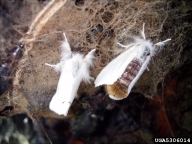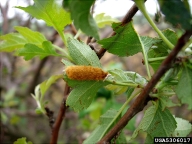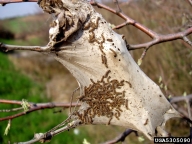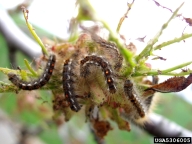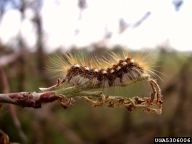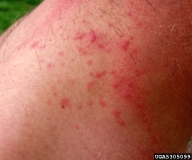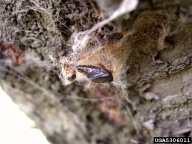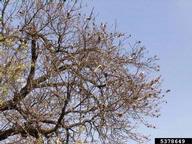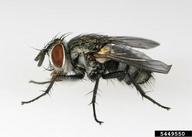Browntail moth
Euproctis chrysorrhoea L. (Lepidoptera: Lymantriidae)
Orientation to pest
Browntail moth, Euproctis chrysorrhoea L., is an invasive species in North America whose effects on trees is similar to that of gypsy moth (Lymantria dispar [L.]), being a defoliator of a wide range of deciduous broadleaf trees. Introduced into North America in the later 19th century, by 1914 it had infested a wide band of coastal and inland New England. In addition to wide spread defoliation of many types of deciduous hardwood trees, including many fruit trees, the species also was a threat to public health because of the severe skin rashes from the caterpillar's hairs. These, if inhaled, could cause illness leading to dead in some cases. By 1922, its range began to quickly collapse and currently the moth is found only in a few small coastal enclaves. While the cause of this decline was not understood at the time, it was subsequently proved to be caused by the action of Compsilura concinnata (Meigen), a polyphagous tachinid introduced against it and the gypsy moth.
Hosts commonly attacked
Browntail moth feeds on most species of deciduous broadleaf trees, especially species of apple (Malus), pear (Pyrus), plum (Prunus), oak (Quercus), willow (Salix), elm (Ulmus), and maple (Acer).
Distribution
At the height of its invasion, browntail moth was found in much of New England, but it is currently found only at the very tip of Cape Cod, Massachusetts and on some islands in Casco Bay, near Portland, Maine.
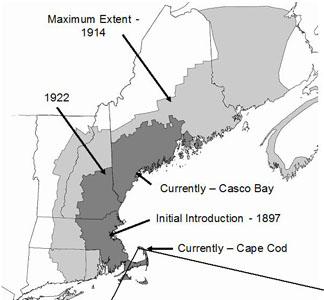 |
| Figure 1. Historical and current distribution of browntail moth, Euproctis chrysorrhoea, in North America |
Images of browntail moth
| Figure 2. Female browntail moth | Figure 3. Egg mass of browntail moth | Figure 4. Young browntail moth caterpillars on web |
| Figure 5. Mature browntail moth caterpillars | Figure 6. Side view of browntail moth caterpillar showing prominent hairs that cause severe skin rash | Figure 7. Skin rash from contact with browntail moth caterpillars |
| Figure 8. Pupae of browntail moth in web | Figure 9. Defoliated trees and old browntail moth webbing | Figure 10. Compsilura concinnata an important tachinid parasitoid of the European gypsy |
Important biological control agents related to this pest species
Elkinton et al. (2006) demonstrated that C. concinnata (Diptera: Tachinidae) was likely the agent responsible for the extinction of browntail moth from much of its former range in North America in the early part of the 20th century. Two other tachinids, Townsendiellomyia nidicola and Carcelia laxifrons, both browntail moth specialists were also introduced and successfully established at the same time as C. concinnata. More recently, a nucleopolyhedrosis virus from England, specific to the moth has been released and established in Maine, but impacts on remaining populations were not yet clear as of 2010. Many browntail moth populations in Maine have been heavily affected by a naturally occurring fungal pathogen, Entomophaga aulicae (Reichardt in Bail) Humber.
Web links for information on browntail moth
Articles
- Elkinton, J. S., D. Parry, and G. H. Boettner. 2006. Implicating an introduced generalist parasitoid in the invasive browntail moth's enigmatic demise. Ecology 87: 2664-2672.
- Elkinton, J. S., E. Preisser, G. Boettner, and D. Parry, D. 2008. Factors influencing larval survival of the invasive browntail moth (Lepidoptera: Lymantriidae) in relict North American populations. Environmental Entomology 37: 1429-1437. Viewable at http://cels.uri.edu/preisserlab/media/publications/preisser/Env%20Ent%202008%20(37,6)%201429-1437.pdf
